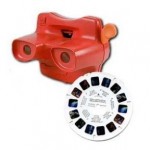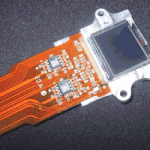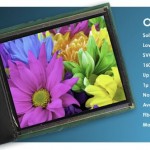The Research Phase
Initially I thought this would be fun, easy. I knew that for an HMD all I would need is a helmet, some goggles, and a display. Not too fussed at this stage about headtracking.
I started looking at what, for many people is their first 3D experience; the View-Master. The View-Master has seen a recent revival – as it is now in the hands of Fisher Price! This cool stereoscopic viewer is as old as the hills, but still has all the essentials of immersive 3D. It has two eye holes, lenses to make things bigger, and two transmissive images, which can
be viewed thanks to external light. Transmissive is a grown up word which means something to do with the transmission of something. In this case, light through the image – from the back to your eye.
Straight away I thought, well – this is easy enough. Did a search with Google and found that, sure enough, somebody else had already done it. http://hackaday.com/2010/08/24/digital-view-master/. Looks funky enough, although those crappy low-res high latency picture frame LCD’s won’t do – but at least it proves it can be done.
So, with a default fall-back headset (I could just glue this to a welders mask and be done) I set off to learn a bit about the actual displays on offer these days.
According to this wiki entry the image that the optics within the View Master are calibrated to focus on is just over a centimeter in size. Being a regular reader of the IT red-tops I know that nowerdays we have Liquid Crystal on Silicon (LCOS) technology and this permits us to create tiny little LCD panels with wonderfully small dot-pitchesand awesome refreshes. They are used in projectors, where their image is still beautiful after being magnified from tiny to huge. Yay for LCOS.
I immediately found this web site which I thought contained the perfect products. But they turned out to be either for photocopiers, or monochrome. Either way they were €1500-3000 a pop.
Monochrome ? Turns out that pretty much all modern LCD based projectors use a system of 3 LCD’s, cleverly called 3LCD. Essentially, rather than have a good old fashioned coloured Active Matrix LCD (AMLCD) you have three high quality mono LCD’s (I actually think they should be called nono) and through each of these you shine red, green and blue light. The really clever thing is the magic prism which merges all these coloured images into one. you can see the inside of the 3LCD ‘light engine’ here. It looks a lot more complex than it is…. Well, conceptually.
I also found a few other LCOS transmissive display manufacturers, including the mighty Kopin who make the Cyberdisplay. The perfect, easy to install, SINGLE transmissive LCOS display. I have been trying to get prices, availability, reseller and distributor information from Kopin for about 3 weeks. Both as a 5 unit minimum purchaser and a 500 unit buyer. Not a single reply to my emails, voicemails or faxes. Kopin can FTFO. But, I still think their Cyberdisplay is the easiest visual solution to implement. Perhaps.
I also looked at Oled displays, of course. A company called eMagin make these, wonderful
little units they are too. Beautiful display, sharp, vibrant – as used, in fact, in the Z800 HMD, among others. I contacted a company called MRA Digital to supply me with the driver boards for eMagins Oled modules. This they were willing to do, but only if I gave
them $7300. eMagin sells it’s wares direct too, but even the SVGA 800×600 modules are $1500 a pop. The z800 3DVisor contains the driver board and 2 SVGA Oled displays and yet costs only $1500. Someone somewhere is being diddled. Therefore, eMagin can FTFO too.
Forth Dimension Displays, a British company, also produce an excellent display for HMD’s – indeed, it is used in quite a few, including Virtual Research VR1280, the Visette SXGA45 and the pocket poundingly high priced Saab Addvisor.
Forth Dimension Displays is named (I think) for it’s funky technology, called ‘Time Domain Imaging’ (TDI). The displays they produce are based upon FLCOS technology, the ‘F’ is for Ferroelectric. From their brochure; “TDI can be defined as the use of temporal methods to create full colour images on an FLCOS microdisplay.” – which in itself does sound awsome! What it means is that their displays are very fast switching and thus can composite the images, including blank frames, this means that motion blur is eliminated. I havn’t has the pleasure of trying out one of their displays yet – I am very much looking forward to that opportunity though. In the mean time, at £4000 a pop – I won’t be using them myself.
So. The fact is, I can’t afford any of this display technology, and even if I could, I would likely have to build custom optics and muck about with controller boards and all the things I know nothing about.



